underdog: Notes on a series by photographer Christopher Schneider
Addie Langford
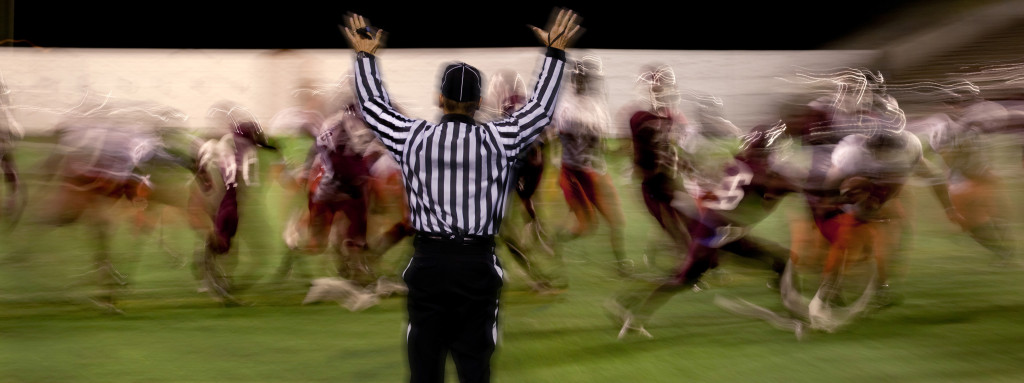
Touchdown

Sidelines, 11 on 1
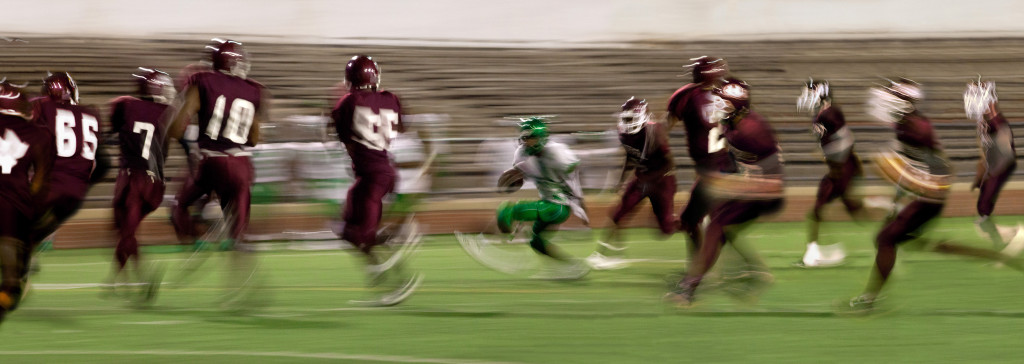
Sidelines, 11 on 1

Pigskin, Hit or Get Hit

Pigskin, Hit or Get Hit
I. After shooting a few stills for a documentary film called Soul Bowl in Miami about two large high school football teams, photographer Christopher Schneider began to ponder the cult of sport. Years later he approached the Hamtramck High School principal, athletics director, and superintendent, to allow him to accompany the team to pursue the question: What is at the heart of the game if it is not glory, when the heroic is stripped away?
Schneider says that “Sports are typically about superstars, records and the pursuit of championships. It is a massive media franchise that sells scandal, passion, and hope. Its presentation, though, has become one-dimensional in its singular pursuit - glory. There’s more to it, of course. Much more.” And then:
When I left college with my teaching degree, I applied for a position in a tiny [425 people] Nebraska town called Stratton. With their tight budget, they asked me what else I could do other than teach. I told them I could coach anything except football, the one sport I had never played in an organized league. They said they needed a football coach. I said I could coach it. I got the job and led the team to a 1-5 season, was demoted to assistant football coach the next season, and the following season was made the assistant volleyball coach. I appreciated the game but didn’t live for it. I believed in its many positive attributes, but never cared for its dominance of the public’s attention and the school budget.
II. As a young athlete, Christopher Schneider played soccer, basketball, baseball and ran cross country which was his strongest sport and would have continued running in college were it not for a heart condition (long since under control). His obsession with statistics led him to nearly complete an actuarial degree when photography caught his attention. He transitioned from thoughts on advanced analytical calculus to the studio of Carl Toth, beloved photographer, former artist in residence at Cranbrook Academy of Art, whose influence opened new professional and conceptual possibilities and introduced him to an arena where he could blend his seemingly disparate strengths and experiences.
III. The dichotomy of the jock/artist has always been a quizzical combination to many as it stands in stark contrast to any number of other cultural images of the hippy/hater/loafer/drab-clad/skinny-art-boy stereo-types, but for professionals inside the art world it is known that successful artists engage a disciplined daily practice, not unrelated to the mindset of dedicated athletes. Schneider’s insights reflect direct exposure to both worlds: “growing up in Nebraska I was a young jock, memorizing statistics and playing every sport (except football, which my mother forbade).” With this comment we sink a bit further into his relationship to the game, the only one to which he was denied entry, the sport he coached unsuccessfully. Fast forward a decade or more to 2010/11 when Schneider spent a season walking the sidelines with a high school football team which had not won a game in five years. An examination of failure, or so he thought. In this series, underdog, the mentality of the pack, the role of the fan base and the team as family emerges. Glory, having been sidelined as well, is no longer a distraction from the aspects of the game that appear to be foundational. Capturing and re-collaging images to point at larger societal trends, football here stands in for lost potentials, saving graces, and the exploration of balance amongst adversity, failure, achievement, and tenacity.
IV. The expression of these guiding thoughts come through large format images, scaled to be three to six feet in length to witness multiple exchanges across the collaged landscape. The photomontages allow the viewer to absorb the varied nature of exchanges of momentary appearing, the photo freeze-framing for us the moving parts that cannot be perceived in phenomenological perception by fans or players. The sprint, the injury, and the pep-talk, tears, empty and full stands can be seen at once. One image contains multiple games and locations unified by the night sky. The color saturation of the uniforms lit by the flood lights creates a striking gem beetle effect. “Each image is an unreal but plausible joining of several images,” says Schneider, “which emphasizes truths about the game that cannot be captured in a single frame. It also separates the work from traditional methods of football imagery.”
V. Decidedly not sports photography, there is a 13th c. tapestry/battle field sensibility to the groupings which evoke tactile and formal references to Giotto’s Legend of Saint Francis in Assisi. In the photograph Home and Away where the coach, arms outstretched in cruciform, sends his message of re-assurance over the lined faces of boys, who, in various states of anguish, search their mentor’s words for ways to escape another loss in progress. In this work, the audience receding in the dark reveals slowly that the away team stands are packed while the home team stands are barren.
VI. The contrasts of empty and full, speed and stillness are at the crux of this body of work; they stand in for the opposing forces at play. Violence and nurturance as well as abundance and absence are present on many levels. Many of these works are composed as binaries with figures staking out in far corners - or are they there to create balance?
There were many challenges facing these players before they reached the field, but no matter how a team is funded, or what the gear or locker room looks like, or even how few teammates a team has to sub out for you, when you are about to be body checked, you simply play - hit or be hit. Escape from immediate concerns is one of the strongest benefits on offer, in fact a complete abandonment of self in the moment. What in the photography began as the attempt to capture an overall loss of a game gave way to the intensity of tiny victories within each play. A play would go right, a small player would clip a big player, every move, and no matter the outcome, was an opportunity to reconnect, to plan for the next play, to focus on the next opportunity to do well. Glory, sport, or football were not the central point – neither the social nor the artistic subject - it was, socially, the warmth and comfort of reliability on team and mentors, or what one might call on its best days, family, and artistically the interlocking forms of dynamism in fields of sudden appearance and collapse, of moments and voids. In terms of individual players, self- esteem or evaluation, the immediacy of assessing outcomes can be a welcome relief to the extended waiting in life, to see if things turn out, appear as one might wish or as a social physics would determine. At the end of two or three hours, you either made the pass, lost or won, and one knew exactly why. The form of the bodies would indicate loss or victory. The power of the known seemed supportive and something to be repeated.
VII. Circling back to the notion of comfort, Schneider comments on the stark contrast of aspects of comfort and support with abject violence, something which is not distinctive to the Hamtramck team, but characteristic of the sport of Football. Harsh language from the stands, the sounds of cracking helmets, grunting and deep and painful hits, against the back drop of constant embrace, affectionate swatting, and holding of hands – among men. It is one of the few public spaces where men engage in an intimate vocabulary of touch, though complex in its entanglement with aggression. The rotation of hits, hugs and huddles are interspersed with prayer and extended embrace where two-dozen people form a tight amoeboid form in solidarity. When was the last time you touched your family or co-workers in this manor? Almost makes one want to play.
VIII. What the photographs capture in the way of complexity of the depth of relationship and psychology for players on the field is also notated in the stands. For the fan, the ability to inhabit dreamed positions, cheer empathetically for favorite players or the place in which one lives, to yell and throw a fist, is all so basic, cathartic and generally frowned upon in classrooms or grocery stores. Where else can a person scream and rant and not get arrested or made to sleep on the couch? In the sports arena. It seems all of this injury and expense is about far more (whether one supports it or not) than scoring points. The absence of the perfect uniforms or full stands for the Hamtramck team seemed to be replaced by friends, purpose, and abiding paternal guidance. In Schneider’s words, “What I found was not innocent or heroic, but in their thriving was a certain kind of beauty. The flow of the game, the sudden collisions, the raw emotions, the athleticism of youth, and the daring disregard for their own comfort shows why sport is a vibrant part of American culture.”

Sack, The Bench
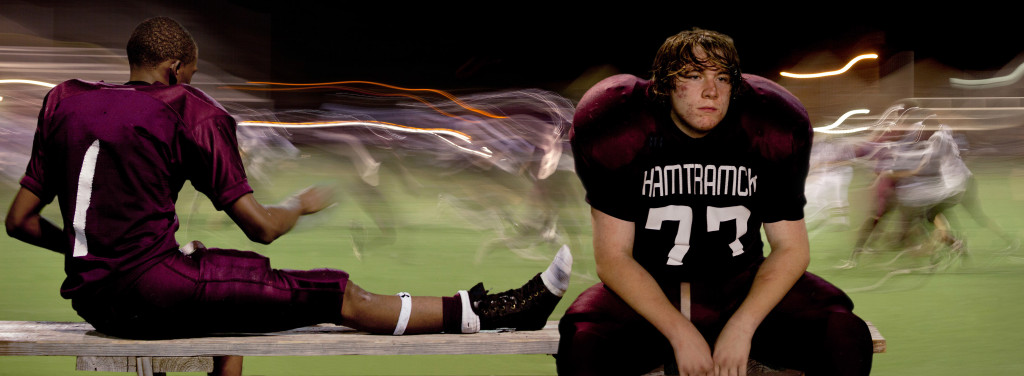
Sack, The Bench
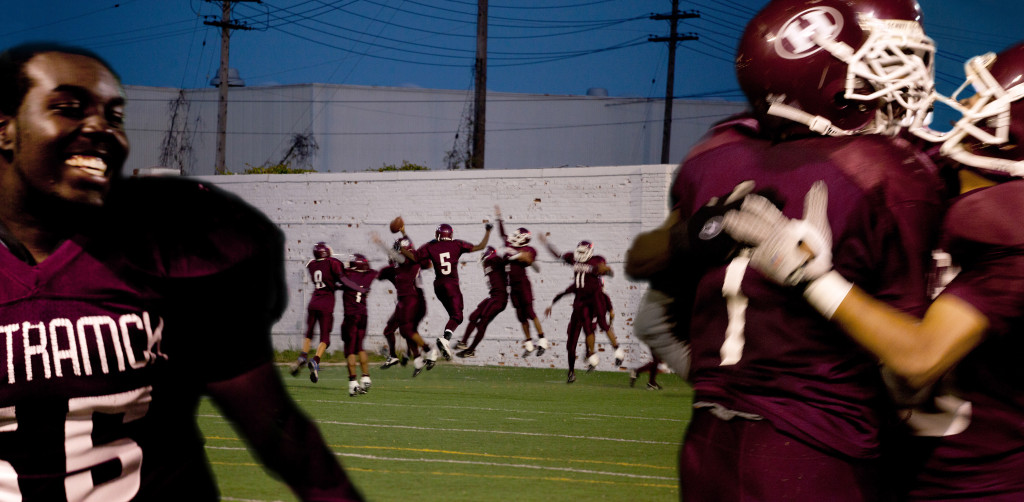
Celebration

Quarterback and Nose Guard

Home and Away
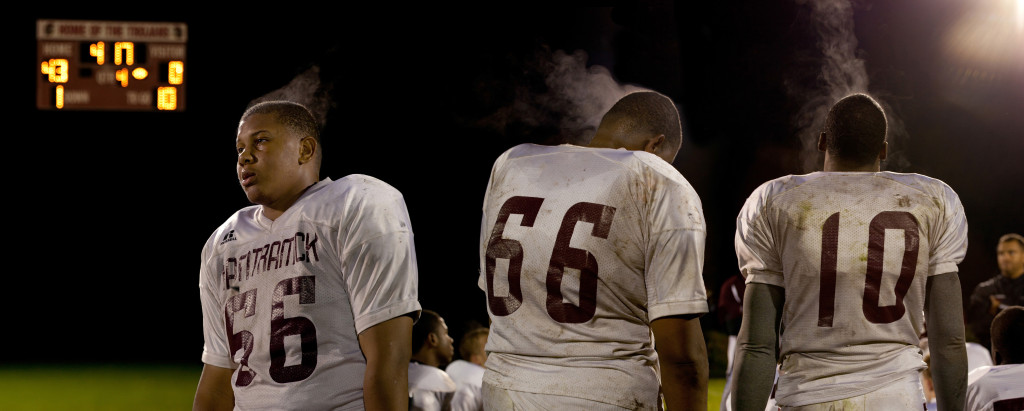
Time Out